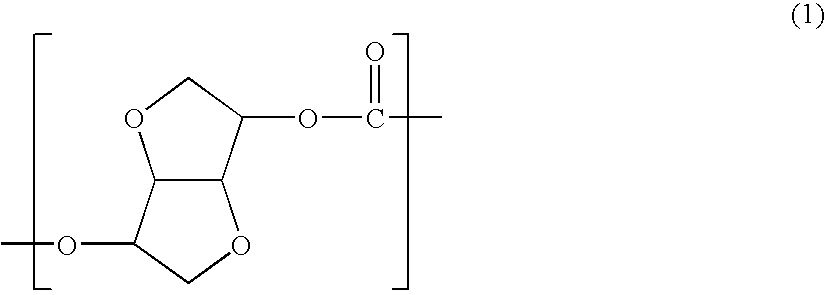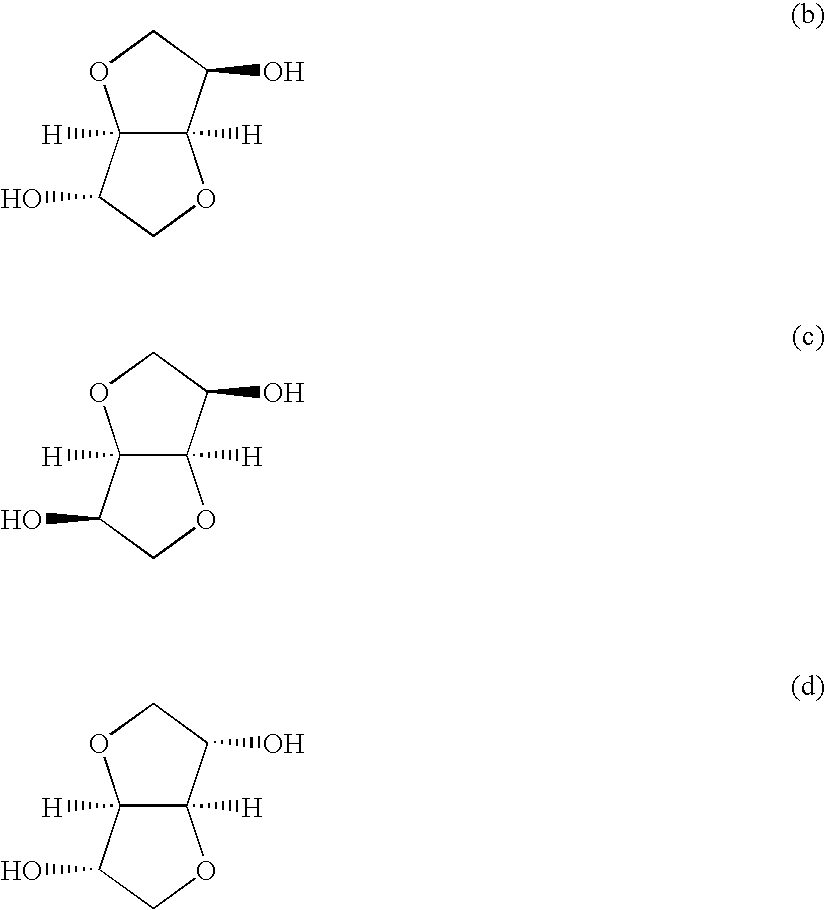Polycarbonate resin composition
a polycarbonate resin and composition technology, applied in the field of polycarbonate resins, can solve the problems of difficult moldability, high viscosity of resins, unsatisfactory value for industrial applications, etc., and achieve the effects of excellent heat resistance, heat stability and moldability, and low melt viscosity
- Summary
- Abstract
- Description
- Claims
- Application Information
AI Technical Summary
Benefits of technology
Problems solved by technology
Method used
Image
Examples
reference example 1
Manufacture of Polycarbonate Resin
[0133]7,307 parts by weight (50 mols) of isosorbide and 10,709 parts by weight (50 mols) of diphenyl carbonate were fed to a reactor, and 4.8 parts by weight (1×10−4 mol based on 1 mol of the diphenyl carbonate component) of tetramethylammonium hydroxide and 5.0×10−3 part by weight (0.25×10−6 mol based on 1 mol of the diphenyl carbonate component) of sodium hydroxide as polymerization catalysts were fed to the reactor and dissolved by heating at 180° C. and normal pressure in a nitrogen atmosphere.
[0134]The inside pressure of the reactor was gradually reduced to 13.3×10−3 MPa over 30 minutes under agitation while the formed phenol was distilled off. After a reaction was carried out in this state for 20 minutes, the temperature was raised to 200° C., the pressure was gradually reduced to 4.00×10−3 MPa over 20 minutes to carryout the reaction for 20 minutes while the phenol was distilled off, and the temperature was further raised to 220° C. to carry ...
reference example 2
Manufacture of Polycarbonate Resin
[0136]A pellet having a specific viscosity of 0.23 was obtained in the same manner as in Reference Example 1 except that a reaction was carried out at 255° C. and 6.66×10−5 MPa for 30 minutes in the end. This pellet had a glass transition temperature of 158° C. and a 5% weight loss temperature of 353° C.
reference example 3
Manufacture of Polycarbonate Resin
[0137]7,307 parts by weight (50 mols) of isosorbide, 10,923 parts by weight (51 mols) of diphenyl carbonate and 270 parts by weight (1.0 mol) of stearyl alcohol were fed to a reactor, and 4.7 parts by weight (1×10−4 mol based on 1 mol of the diphenyl carbonate component) of tetramethylammonium hydroxide and 4.0×10−3 part by weight (0.20×10−6 mol based on 1 mol of the diphenyl carbonate component) of sodium hydroxide as polymerization catalysts were fed to the reactor and dissolved by heating at 180° C. and normal pressure in a nitrogen atmosphere.
[0138]The inside pressure of the reactor was gradually reduced to 13.3×10−3 MPa over 30 minutes under agitation while the formed phenol was distilled off. After a reaction was carried out in this state for 20 minutes, the temperature was raised to 200° C., the pressure was gradually reduced to 4.00×10−3 MPa over 20 minutes to carry out the reaction for 20 minutes while the phenol was distilled off, and the ...
PUM
| Property | Measurement | Unit |
|---|---|---|
| weight loss temperature | aaaaa | aaaaa |
| Tg | aaaaa | aaaaa |
| mol % | aaaaa | aaaaa |
Abstract
Description
Claims
Application Information
 Login to View More
Login to View More - R&D
- Intellectual Property
- Life Sciences
- Materials
- Tech Scout
- Unparalleled Data Quality
- Higher Quality Content
- 60% Fewer Hallucinations
Browse by: Latest US Patents, China's latest patents, Technical Efficacy Thesaurus, Application Domain, Technology Topic, Popular Technical Reports.
© 2025 PatSnap. All rights reserved.Legal|Privacy policy|Modern Slavery Act Transparency Statement|Sitemap|About US| Contact US: help@patsnap.com



